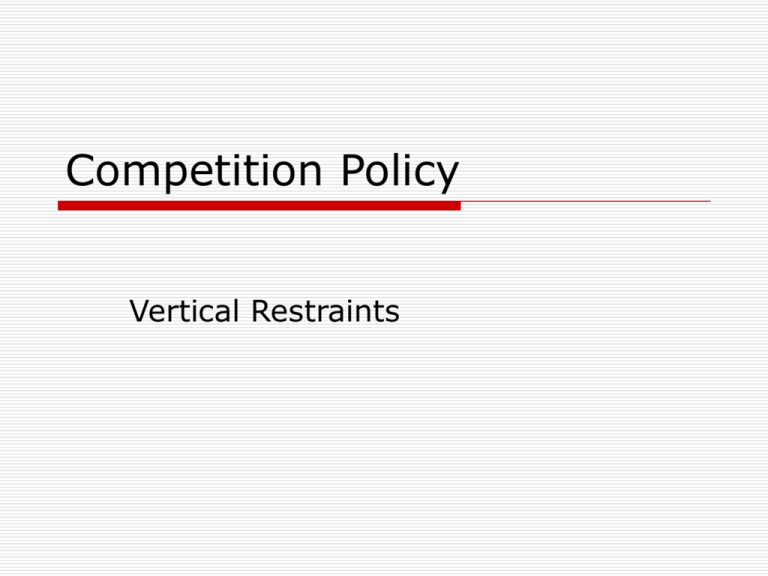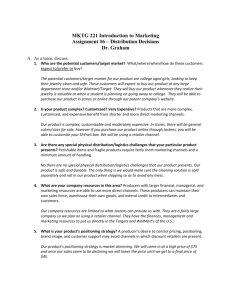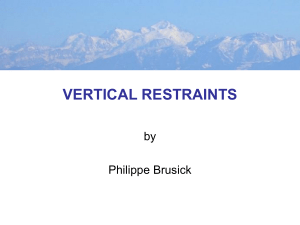Competition Policy
advertisement

Competition Policy Vertical Restraints What are vertical restraints? In many markets producers sell their goods through intermediaries: wholesalers and retailerssign contracts to guarantee supply stability and improve coordination These agreements in the vertical chain are called vertical restraints What is optimal for a manufacturer is not necessarily optimal for the retailer one party can try to use contracts to restrain choice and induce the best outcome for itself Example: the manufacturer wants to improve the marketing efforts of the retailer1) it may assign an exclusive area to the retailer so that the latter will fully appropriate the results of his efforts 2) It may use a non-linear wholesale price (the retailer gets a discount if it buys a large quantity of the goods) Most common vertical restraints Non linear pricing Quantity discounts Resale price maintenance (makes sense if the price paid by the consumer is observable as in the case of consumer goods If the manufacturer finds it difficult to use contracts then it could resort to vertical integration merge with (or take over) the retailer Intra-Brand Competition Welfare effects of vertical restraints whne they affect competition between retailers that sell the same product (or brand) A manufacturer (monopolist) may sell through one or more retailers If both the M and the R have market power, both charge a positive mark-up the final price is too highDouble Marginalizationwith vertical restraints or vertical integration price would decrease and welfare would increase If several retailers distributed the same brand they would be unable to appropriate their marketing effortthey reduce their efforts Underprovision of sales servicesvertical restraints give incentives to retailers to improve their effortEX.Give exclusive territories if consumers value these services welfare increases The Commitment Problem Vertical restraints and vertical mergers may have an adverse effect on welfare when they help the manufacturer to keep prices highwithout them it would not be able to commit to high prices EX.a successful brand has not beeen sold yet ina region – the expected profit from selling it is Π – several franchisee are ready to sell the brandIf the manufacturer offered exclusivity to one franchisee competitive bidding will lead the winning bidder to offer Π to the up-stream firm The Commitment Problem Once it has sold the franchise the up-stream has an incentive to renege on its exclusivity promise and offer a second franchisee (promising there will be no more than two) and obtain an additional gain Π/2 (the first franchisee incurs a loss = Π/2 )…then it can offer a third franchisee… Potential franchisee would anticipate this behaviour and if the manufacturer is unable to commit on a single franchisee then nobody wants the licence.. The Commitment Problem Because of this problem a firm cannot appropriate its potential market power in the example the franchisee could accept to buy the licence only at a low price and the producer gains a low profit The same commitment problem arises when a firm has an input to be sold to more than one buyer incentive to renegotiate the contract with some buyers after having concluded the contract with all of them if contracts are not observable better terms can be renegotiated with some buyers Vertical Mergers An obvious solution for the manufacturer to commit to higher prices is to merge with one of the downstream firmsit internalizes the profit made by its affiliate it has no incentive to offer better terms to other downstream firms (it will reduce the profit made by its affiliate) The foreclosure of rival downstream firms will follow as the upstream unit would not supply the input to rival retailersmonopoly power is restored! (if there are no competing suppliers of the input) With alternative (less efficient) upstream suppliers prices will increase but to a less extent, due to the retailers threat to switch suppliers limit to the exercise of market powerso vertical restraints may negatively affect welfare but the nefative effects may be limited by the existence of competing suppliers Exclusive territories If it is possible to conclude a legal contract that grant exclusivity to one supplier in each area then the manufacturer problem is solved In the region protected by esclusivity competition among retailers will bring them to pay up to the monopoly price to be a monopolist retailer in the area the manufacturer restores its market power Exclusive territories then harm welfare consumers pay the monopoly price rather than the lower price to be set without the esclusivity clause Resale Price Maintenance Since the problem of the monopolist is to avoid renegotation that leads to lower prices the commitment problem is solved if the monopolist commit to industry-wide prices EX.RPM clauses as in the case of books or pharmaceuticalsthe producer prints the price on the products that cannot be sold at a discount price (the retailer can be taken to courts if it did) There is no incentive for the producer to cut secretly wholesale prices a price cut would not increase final slaes but worsen the distribution of profits between the producer and the retailer that receives a discount Conclusions The magnitude of the damage created by vertical restraints (or a vertrical maerger) depends on the upstream firm being or not a monopolist if there are competing suppliers the damage is lowcompetition policies should then monitor such practices only when undertaken by firms with enough market power The Commitment Problem








